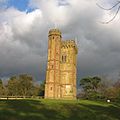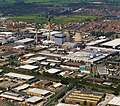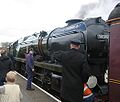Portal:South East England
The South East England Portal

South East England is one of the nine official regions of England in the United Kingdom at the first level of ITL for statistical purposes. It consists of the nine counties of Berkshire, Buckinghamshire, East Sussex, Hampshire, the Isle of Wight, Kent, Oxfordshire, Surrey and West Sussex. Cities and towns in the region include Aldershot, Ashford, Aylesbury, Basingstoke, Bracknell, Brighton and Hove, Canterbury, Chichester, Crawley, Eastbourne, Farnborough, Gosport, Guildford, Hastings, High Wycombe, Margate, Maidstone, Medway, Milton Keynes, Newport, Oxford, Portsmouth, Ramsgate, Reading, Slough, Southampton, Winchester, Woking and Worthing.
South East England is the third-largest region of England, with a land area of 19,072 square kilometres (7,364 sq mi), and is also the most populous with a total population of 9,379,833 in 2022. The region contains eight legally chartered cities: Brighton and Hove, Canterbury, Chichester, Milton Keynes, Oxford, Portsmouth, Southampton and Winchester. The region's close proximity to London has led to South East England becoming a prosperous economic hub with the largest economy of any region in the UK, after London. The region is home to Gatwick Airport, the UK's second-busiest airport, and Heathrow Airport (the UK's busiest airport) is located adjacent to the region's boundary with Greater London. The coastline along the English Channel provides numerous ferry crossings to mainland Europe.
The region is known for its countryside, which includes two national parks: the New Forest and the South Downs, as well as the North Downs, the Chiltern Hills and part of the Cotswolds. The River Thames flows through the region and its basin is known as the Thames Valley. It is also the location of a number of internationally known places of interest, such as HMS Victory in Portsmouth, Cliveden in Buckinghamshire, Thorpe Park and RHS Wisley in Surrey, Blenheim Palace in Oxfordshire, Windsor Castle in Berkshire, Leeds Castle, the White Cliffs of Dover and Canterbury Cathedral in Kent, Brighton Palace Pier, and Hammerwood Park in East Sussex, and Wakehurst Place in West Sussex. The region has many universities; the University of Oxford is the oldest in the English-speaking world, and ranked among the best in the world.
South East England is host to various sporting events, including the annual Henley Royal Regatta, Royal Ascot and The Derby, and sporting venues include Wentworth Golf Club and Brands Hatch. Some of the events of the 2012 Summer Olympics were held in the south east, including the rowing at Eton Dorney and part of the cycling road race in the Surrey Hills.
In medieval times, South East England included much of the Kingdom of Wessex, which was the precursor to the modern state of England. Winchester was the capital of England after unification of the various states, including the kingdoms of Kent, Sussex and Mercia. Winchester stopped being the administrative capital of England some time in the 13th century as its influence waned while the City of London dominated commerce. The last monarch to be crowned at Winchester was Richard II in 1377, although the last monarch to be crowned by the Bishop of Winchester was Queen Mary I in 1553. (Full article...)
Selected article
Southampton Football Club (/saʊθˈ(h)æmptən/ ) is a professional football club based in Southampton, Hampshire, England. The club competes in the Premier League, the top tier of English football, after achieving promotion in the 2024 EFL Championship play-off final. Its home ground since 2001 has been St Mary's Stadium, before which it was based at The Dell. The team play in red and white shirts. They have been nicknamed "The Saints" because of the club's beginnings as a church football team at St Mary's Church. Southampton shares a long-standing South Coast derby rivalry with Portsmouth, in part due to geographic proximity and both cities' respective maritime histories.
Founded in 1885, the club joined the Southern League as Southampton St. Mary's in 1894, dropping the St. Mary's from their name three years later. Southampton won the Southern League on six occasions and were beaten FA Cup finalists in 1900 and 1902, before being invited to become founder members of the Football League Third Division in 1920. They won promotion as Third Division South champions in 1921–22, remaining in the Second Division for 31 years until they were relegated in 1953. Crowned Third Division champions under the stewardship of Ted Bates in 1959–60, they were promoted into the First Division at the end of the 1965–66 campaign. They played top-flight football for eight seasons, but won the FA Cup as a Second Division team in 1976 with a 1–0 victory over Manchester United. Manager Lawrie McMenemy then took the club back into the top-flight with promotion in 1977–78.
Southampton were beaten finalists in the League Cup in 1979 and finished as runners-up in the First Division in 1983–84, three points behind Liverpool. The club were founder members of the Premier League in 1992 and reached another FA Cup final in 2003. Relegation ended their 27-year stay in the top-flight in 2005, and they were relegated down to the third tier in 2009. Southampton won the Football League Trophy in 2010 and won successive promotion from League One and the Championship in 2010–11 and 2011–12. After an 11-year stint in the top flight, during which they were EFL Cup runners-up in 2017, they were relegated in 2023. The club won the 2024 Championship play-off final and returned to the Premier League at the first attempt. (Full article...)
Selected pictures
Selected biography
Sir Frederick Alfred Laker (6 August 1922 – 9 February 2006) was an English airline entrepreneur, best known for founding Laker Airways in 1966, which went bankrupt in 1982. Known as Freddie Laker, he was one of the first airline owners to adopt the "low cost / no-frills" airline business model that has since proven to be successful worldwide when employed by companies such as Ryanair, Southwest Airlines, easyJet, Norwegian Air, and AirAsia. (Full article...)
On This Day in South East England
21 November:
1916: The HMHS Britannic sunk en route from Southampton to Lemnos following an explosion. 30 people died.
Categories
Related portals
WikiProjects
Topics
Associated Wikimedia
The following Wikimedia Foundation sister projects provide more on this subject:
-
Commons
Free media repository -
Wikibooks
Free textbooks and manuals -
Wikidata
Free knowledge base -
Wikinews
Free-content news -
Wikiquote
Collection of quotations -
Wikisource
Free-content library -
Wikiversity
Free learning tools -
Wikivoyage
Free travel guide -
Wiktionary
Dictionary and thesaurus































































































































